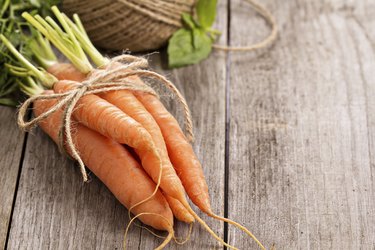
The pancreas is a gland that lies deep within the abdomen. It plays an integral part in the digestive system; combining enzymes with the digestive juices from the intestines to complete the breakdown of carbohydrates, protein and fat. The pancreas is also responsible for secreting hormones that regulate blood glucose levels. The pancreas typically goes unnoticed until problems occur. Removal of the pancreas is a serious surgical procedure that changes the composition of the entire digestive system. A special diet that eliminates certain foods is required to avoid adverse health complications.
Raw Fruits and Vegetables
Video of the Day
Fruits and vegetables provide your body with essential vitamins, minerals and antioxidants that it needs to develop, heal and maintain health. While you should eat several servings of fruits and vegetables each day, you should avoid eating them raw. Choose vegetables that are well-cooked or steamed and fruits that are stewed or canned. Carrots, zucchini, squash, well-ripened melon, applesauce and soft bananas are good choices. Fresh produce is more difficult to digest, and because of its higher fiber content can cause diarrhea after your pancreas is removed. Avoid tough vegetables, legumes and fruits with skins or seeds such as apples, pears, berries and citrus fruits other than pulp-free juices.
Video of the Day
Meat
Following the removal of your pancreas, it is important to consume foods that are easily digested. Therefore, you should avoid tough and fibrous meats such as veal, lamb, beef and pork, which require release of pancreatic enzymes for complete digestion. Additionally, you should avoid high-fat, greasy and fried meats including hamburgers, steak, ham, lunch meats, hot dogs, sausage and bacon. General recommendations include eating fewer red meats and consuming more lean meats, cold-water fish, eggs and tofu. Select steamed, broiled or grilled fish and chicken with no skin or breading, soft-cooked, poached or scrambled eggs and peanut butter to meet your protein needs. Use healthy oils such as olive or vegetable oil when cooking. Recovery time is highly individual, and you may be able to resume eating tougher cuts of meat within one to three months.
Sugar
One of the primary functions of the pancreas is insulin production for proper blood sugar control. Therefore, removal of the pancreas results in the decreased insulin production and increased risk of developing diabetes. If you have diabetes or have abnormally high levels of blood sugar, your diabetes may worsen after surgery. However, if you don't have diabetes, you have a lower chance of developing diabetes after surgery. You should avoid concentrated or refined sugars such as white bread, pasta, rice, crackers, processed items and commercial baked goods such as cookies, cakes and doughnuts. These foods raise blood sugar levels quickly and may result in glucose intolerance. Oatmeal, brown rice, whole-wheat bread and whole-grain pasta are better choices.
Dairy
It is important to eliminate all foods that cause a suspected food allergy, including dairy. If you have a lactose intolerance, you should avoid dairy products such as milk, cheese, eggs and ice cream. Enzymes are necessary in the breakdown of carbohydrates or sugars in milk. Therefore, you may even develop a new intolerance to dairy products. However, yogurt is typically well-tolerated. Try to eat yogurt with lactase 2 to 3 times per day. After pancreatic removal, your dietary needs will be very individualized. You may be able to tolerate dairy products while others cannot.
Liquids
Drinking plenty of liquids, between 6 to 10 cups per day, is very important. However, you should steer clear of carbonated, caffeinated and alcoholic beverages. Additionally, you should drink the majority of your fluids between meals, not with meals. Consuming excess liquids at mealtime will interfere with your intake of solid foods and make you feel full more quickly. The general rule is to consume small meals throughout the day and drink liquids an hour before or after eating to avoid feeling full. Choose beverages such as juice, smoothies, supplements, milk, water and sports drinks that are calorie- and nutrient-dense.
- University of Maryland Medical Center; Pancreatitis; Steven D. Ehrlich, N.M.D.; August 2008
- Colombia University Medical Center: Dietary Guidelines for Patients Who Have Undergone Pancreatic Resections
- Pancreatic Cancer Action Network: Nutrition After a Whipple Procedure
- University of Virginia Health System: Whipple Procedure – Nutritional Concerns
- Cancer Help UK: Diet and Pancreatic Cancer
- The Pancreas Center: What to Expect After an Operation
- John Hopkins Medicine: Post-Surgery Diet Tips